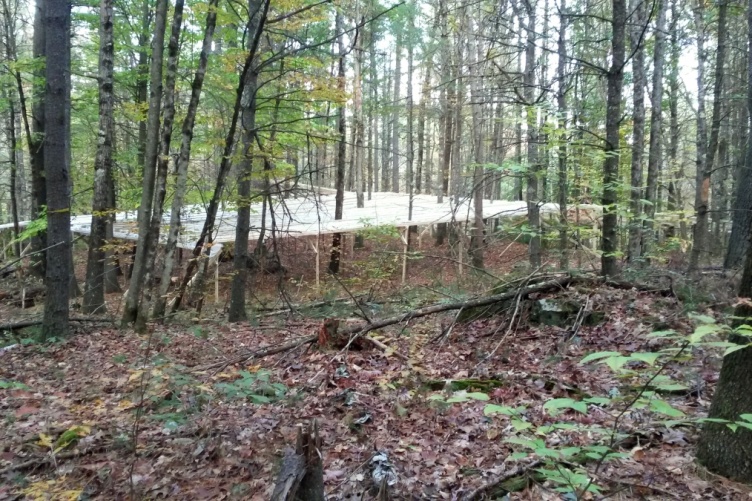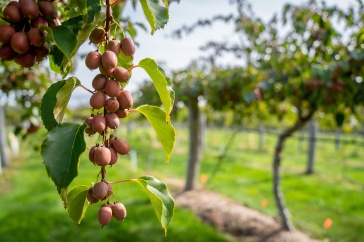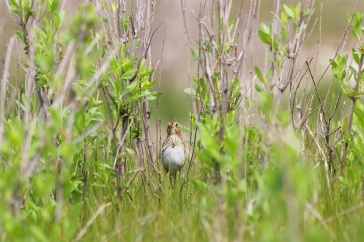
Experiment station scientists plan to remove 55 percent of incoming precipitation at this throughfall structure at the Thompson Farm.
Researchers with the NH Agricultural Experiment Station at the University of New Hampshire have launched a multi-year research project to investigate how droughts may impact Northern forests, which play a critical role in protecting and regulating water resources.
“Forests in the Northeast provide critical hydrologic benefits to society, including clean and reliable drinking water, flood control, and regulation of stream flow for wildlife and human populations. Climate change is already causing an increase in the frequency and intensity of extreme rainfall events, including both intense storms and droughts. This trend is expected to continue in the future, and will likely have important consequences for plant growth and mortality, pest outbreaks, and the capacity of forests to provide hydrologic benefits to society,” according to experiment station researcher Heidi Asbjornsen, associate professor of ecosystem ecology.
“This research aims to improve understanding about the impacts of climate change and altered rainfall patterns on forest health, productivity, and hydrology. The results will provide crucial information to citizens, policy makers, and managers needed to make effective decisions for ensuring the sustainability of forests and water resources in the future,” Asbjornsen said.

According to the NH Division of Forests and Lands, New Hampshire is nearly 84 percent forested, and the forest’s direct impact on the economy of the state is $2.26 billion annually. This research will enhance understanding of how forests will respond to anticipated climate change-induced alterations in rainfall and the influence it may have on the ecosystem services, quality of life, and economic security. The research is particularly important to foresters, land managers, and landowners.
Researchers are focusing on two tree species, the eastern white pine and northern red oak. According to Cameron McIntire, a doctoral student in Asbjornsen’s lab whose dissertation research focuses on the experiment station-funded project, these trees are common to New England forests and represent significant economic and ecological value in the region.
Asbjornsen and her research team are trying to simulate a 55 percent reduction in the annual growing season precipitation at the UNH Thompson Farm Observatory in Durham. The 55 percent reduction threshold was determined following a review of 100 years of precipitation records, which revealed that this decrease in rain in the early 1960s coincided with a severe drought and represents a 1-in-100-year drought event.
UNH researchers plan to remove about 55 percent of the rainfall that would typically fall through the trees and reach the ground. The “throughfall” structure now in place will achieve this by not allowing this percentage of rain to reach the forest floor.
Scientists will monitor the throughfall structure for four years, measuring seasonal changes in soil moisture content, soil respiration, decomposition, tree water use, and biomass accumulation.
“We are uncertain how tree species adapted to the relatively moist conditions of the Northeastern temperate forests will respond to prolonged periods of drought stress. Our research findings will be important for understanding how trees regulate physiological processes such as transpiration and photosynthesis in response to drought and will help inform ecosystem drought responses on a global scale,” McIntire said.
This material is based upon work supported by the NH Agricultural Experiment Station, through joint funding of the National Institute of Food and Agriculture, U.S. Department of Agriculture, under award number 1003450, and the state of New Hampshire. The experiment also is funded by the Northeastern States Research Cooperative, and is part of the National Science Foundation-funded Drought-Net global network.
Founded in 1887, the NH Agricultural Experiment Station at the UNH College of Life Sciences and Agriculture is UNH’s original research center and an elemental component of New Hampshire's land-grant university heritage and mission. We steward federal and state funding, including support from the USDA National Institute of Food and Agriculture, to provide unbiased and objective research concerning diverse aspects of sustainable agriculture and foods, aquaculture, forest management, and related wildlife, natural resources and rural community topics. We maintain the Woodman and Kingman agronomy and horticultural farms, the Macfarlane Greenhouses, the Fairchild Dairy Teaching and Research Center, and the Organic Dairy Research Farm. Additional properties also provide forage, forests and woodlands in direct support to research, teaching, and outreach.
-
Written By:
Lori Tyler Gula, PhD | NH Agricultural Experiment Station | lori.gula@unh.edu | 603-862-1452



















































